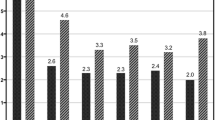Abstract
Background
Information on male potency in lymphoma survivors is insufficient. In this study, we assessed male sexual function and serum gonadotropins in successfully treated lymphoma patients.
Materials and methods
Fifty-nine patients treated for Hodgkin’s lymphoma (HL) or non-HL (NHL) with chemotherapy ± radiotherapy were included in the study.
Results
The mean age (±standard deviation) of the patients was 40.2 ± 11.0 (range, 18–55 years). Thirty-eight (64.4%) had HL and 21 (35.6%) NHL. According to the International Index of Erectile Function (IIEF) score, 61.0% had some degree of erectile dysfunction (ED; IIEF score < 26): 33.9% had mild ED (IIEF score 17–25), 15.2% moderate ED (IIEF score 11–16), and 11.9% severe ED (IIEF score 6–10). Age distribution was similar in patients with ED and those with normal erectile function. Presence of ED and its grade were not different between HL and NHL patients. Nine (18.4%) of 49 patients had an elevated follicle-stimulating hormone, 7 (14.2%) had elevated luteinizing hormone, and 3 (6.1%) had decreased testosterone levels. These hormonal abnormalities did not affect the presence of ED and its severity.
Conclusions
Overall, 61.0% of men in our study had ED according to IIEF. Clinicians should be aware of this problem in lymphoma survivors and offer these patients adequate treatment options.

Similar content being viewed by others
References
Althof SE (2002) Quality of life and erectile dysfunction. Urology 59:803–810
Giwercman A, Petersen PM (2000) Cancer and male infertility. Baillieres Best Pract Res Clin Endocrinol Metab 14:453–471
Bloom JR, Fobair P, Gritz E, Wellisch D, Spiegel D, Varghese A, Hoppe R (1993) Psychosocial outcomes of cancer: a comparative analysis of Hodgkin’s disease and testicular cancer. J Clin Oncol 11:979–988
Brotons FB, Campos JC, Gonzalez-Correales R, Martin-Morales A, Moncada I, Pomerol JM (2004) Core document on erectile dysfunction: key aspects in the care of a patient with erectile dysfunction. Int J Impot Res 16(Suppl 2):S26–S39
Rosen RC, Riley A, Wagner G, Osterloh IH, Kirkpatrick J, Mishra A (1997) The international index of erectile function (IIEF): a multidimensional scale for assessment of erectile dysfunction. Urology 49:822–830
Ponholzer A, Temml C, Mock K, Marszalek M, Obermayr R, Madersbacher S (2005) Prevalence and risk factors for erectile dysfunction in 2869 men using a validated questionnaire. Eur Urol 47:80–85, discussion 85–86
Feldman HA, Goldstein I, Hatzichristou DG, Krane RJ, McKinlay JB (1994) Impotence and its medical and psychosocial correlates: results of the Massachusetts Male Aging Study. J Urol 151:54–61
Das PK, Das BK, Sahu DC, Mohanty GN, Rath RN (1994) Male gonadal function in Hodgkin’s disease before and after treatment. J Assoc Phys India 42:604–605
Schrader M, Muller M, Sofikitis N, Goessl C, Straub B, Miller K (2002) Testicular sperm extraction prior to treatment in azoospermic patients with Hodgkin’s disease. Ann Oncol 13:333
Viviani S, Ragni G, Santoro A, Perotti L, Caccamo E, Negretti E, Valagussa P, Bonadonna G (1991) Testicular dysfunction in Hodgkin’s disease before and after treatment. Eur J Cancer 27:1389–1392
Rueffer U, Breuer K, Josting A, Lathan B, Sieber M, Manzke O, Grotenhermen FJ, Tesch H, Bredenfeld H, Koch P, Nisters-Backes H, Wolf J, Engert A, Diehl V (2001) Male gonadal dysfunction in patients with Hodgkin’s disease prior to treatment. Ann Oncol 12:1307–1311
Chapman RM, Sutcliffe SB, Malpas JS (1981) Male gonadal dysfunction in Hodgkin’s disease. A prospective study. JAMA 245:1323–1328
Türk Androloji Derneği IIEF Validasyon Grubu (2002) Erektil İşlevi Uluslararası Değerlendirme formu (IIEF) Türkçe Versiyonu,. 4. Ulusal Cinsel İşlev Bozuklukları Kongresi Özet Kitabı, İstanbul, vol 43
Hartmann JT, Albrecht C, Schmoll HJ, Kuczyk MA, Kollmannsberger C, Bokemeyer C (1999) Long-term effects on sexual function and fertility after treatment of testicular cancer. Br J Cancer 80:801–807
Relander T, Cavallin-Stahl E, Garwicz S, Olsson AM, Willen M (2000) Gonadal and sexual function in men treated for childhood cancer. Med Pediatr Oncol 35:52–63
Fossa SD, Aabyholm T, Vespestad S, Norman N, Ous S (1993) Semen quality after treatment for testicular cancer. Eur Urol 23:172–176
Fobair P, Hoppe RT, Bloom J, Cox R, Varghese A, Spiegel D (1986) Psychosocial problems among survivors of Hodgkin’s disease. J Clin Oncol 4:805–814
Tross S (1984) Psychological sequelae of cured cancer: testicular cancer as a model. In Current concepts in psycho-oncology. Memorial Sloan-Kettering, New York, pp 17–25
Cella D (1983) Psychosocial adjustment over time to the successful treatment of early versus late stage Hodgkin’s disease in young adult men. Doctoral thesis. Graduate School of Loyola University, Chicago, Chicago
Chatterjee R, Palla K, Kottaridis PD (2004) Cavernosal arterial insufficiency and metabolic syndrome probably represent a common pathology of endothelial dysfunction in recipients of high-dose therapy and stem-cell transplantation. J Clin Oncol 22:2253–2254
Ragni G, Bestetti O, Santoro A, Viviani S, Di Pietro R, De Lauretis L (1985) Evaluation of semen and pituitary gonadotropin function in men with untreated Hodgkin’s disease. Fertil Steril 43:927–930
Puscheck E, Philip PA, Jeyendran RS (2004) Male fertility preservation and cancer treatment. Cancer Treat Rev 30:173–180
Hoekstra HY, GJ-P, Sonneveld DJ, va Imhoff G, van d Wiel H, va Driel M, Schrafford Koops H, Sleijfer DT (1998) Sexuality after combined modality treatment for testicular cancer or Hodgkin’s Disease; Is there a difference between both cancer survivor groups. The American Society of Clinical Oncology Annual Meeting, Los Angeles, CA
Acknowledgments
The results of this study were presented in part at the 42nd Annual Meeting of the American Society of Clinical Oncology, Atlanta, GA, 2–6 June 2006.
Author information
Authors and Affiliations
Corresponding author
Rights and permissions
About this article
Cite this article
Aksoy, S., Harputluoglu, H., Kilickap, S. et al. Erectile dysfunction in successfully treated lymphoma patients. Support Care Cancer 16, 291–297 (2008). https://doi.org/10.1007/s00520-007-0307-y
Received:
Accepted:
Published:
Issue Date:
DOI: https://doi.org/10.1007/s00520-007-0307-y




